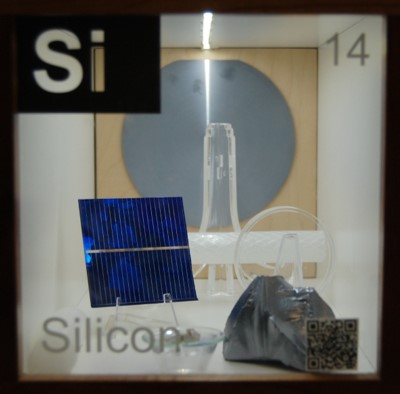Silicon

Contributors: Since silicon has so many applications and uses, it is only fitting that we would have several different contributors for this element! Professor Edith Kippenhan, Detlef Klingberg, Lindsay Young, Dr. Dean Giolando, and Dr. Tomer Avidor-Reiss were all contributors to this display.
About the Display: This display features:
- A headlight from a Mercedes Benz (donated by Edith Kippenhan and Detlef Klingberg) - the entire headlight is made of silicon instead of glass, allowing it to be flexible. Due to the increased flexibility, the headlights can change how the light is distributed. See the video below!
- Silicone tubing (donated by Edith Kippenhan and Detlef Klingberg) - silicone tubing is used in areas of temperatures of both extremes. In low temperatures, the silicone will not harden to the point of cracking. Silicone tubing can also withstand high temperatures without compromising its structure.
- Insulator foam (donated by Edith Kippenhan and Detlef Klingberg) - like tubing, silicone insulation does not swell and contract with temperature
- A piece of pure silicon
- A silicon solar cell (donated by Dean Giolando)
- A silicon wafer (donated by Lindsay Young) - used to x-ray diffraction standards
- Opal (donated by Lindsay Young) - the coloring of opal occurs because of tiny silica spheres that diffract light, causing the rainbow-like sheen
Silicon versus Silicone - What's the difference?
Silicon is a naturally occurring shiny bluish-silver metalloid. The element in its pure form is not common, although silicon is the second most abundant element in the earth's crust following oxygen. Pure silicon is most notably used in technology, where it is used to make semiconductors.
Silicone is a polymer, or molecule chain, consisting of a backbone of silicon and oxygen atoms connected to other atoms (usually carbon and/or hydrogen). This backbone is known as siloxane. The properties of different types of silicone change depending on which organic group is attached to the siloxane chain.

Pictured: Siloxane
Crash Course - Silicon
Applications of Silicone in the Kitchen
How Mercedes Benz is Using Silicone



Pictured (left to right): Lindsay Young, Edith Kippenhan, Dean Giolando
About the Contributors: Lindsay Young is a UT alumna who now works with Proto Manufacturing. Professor Edith Kippenhan is a former lecturer of chemistry at the University of Toledo. Detlef Klingberg is an acquaintance of Prof. Kippenhan who works for Wacker Chemical Corporation. Dr. Giolando is a former professor of chemistry at the University of Toledo. Dr. Avidor-Reiss is a professor of biology at the University of Toledo.
Back to the Periodic Table
Symbol: Si
Atomic Number: 14
Atomic Mass: 28.0855 u
Electron Configuration: [Ne] 3s23p2
Year Discovered: 1823
Discovered By: Jöns Jacob Berzelius


